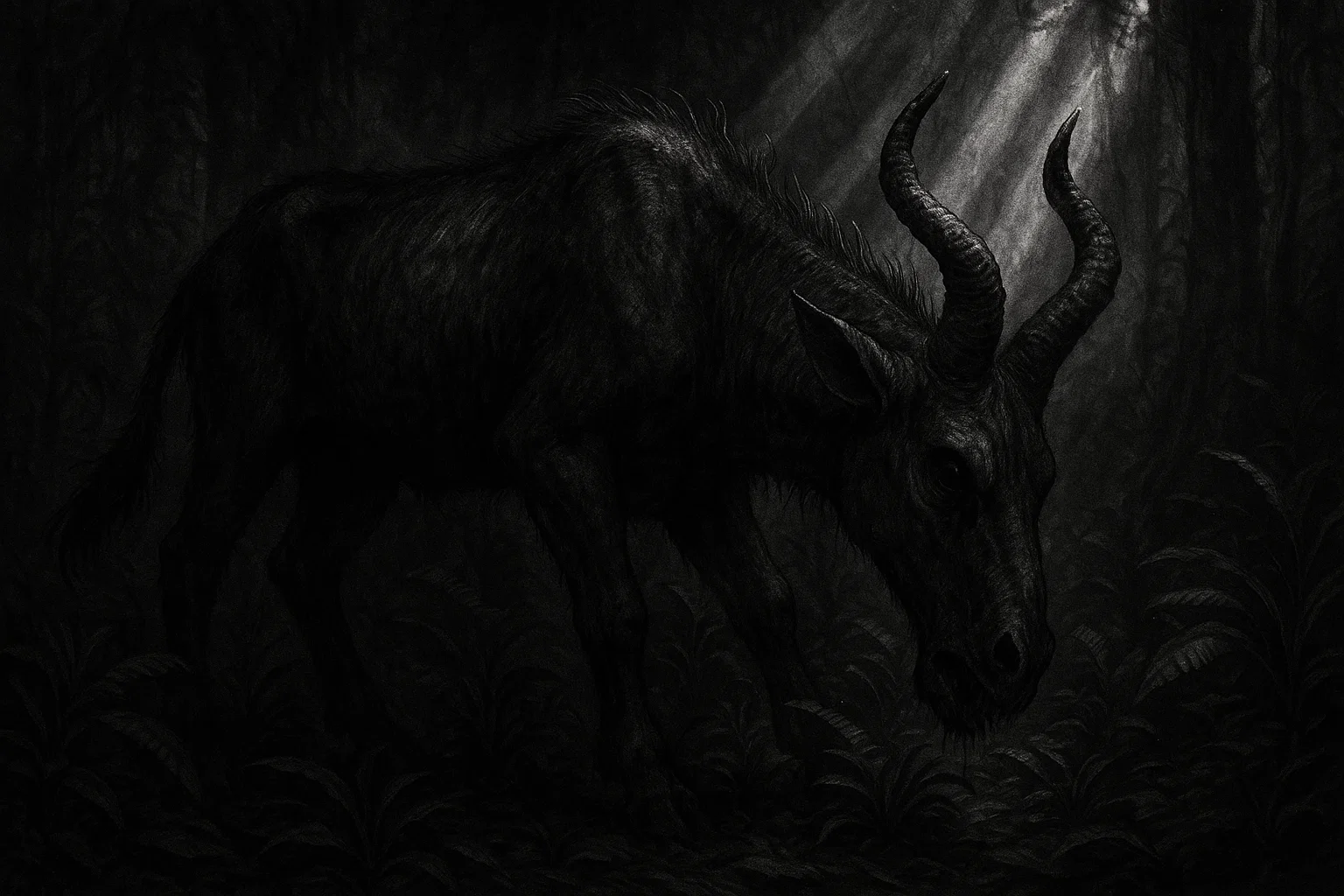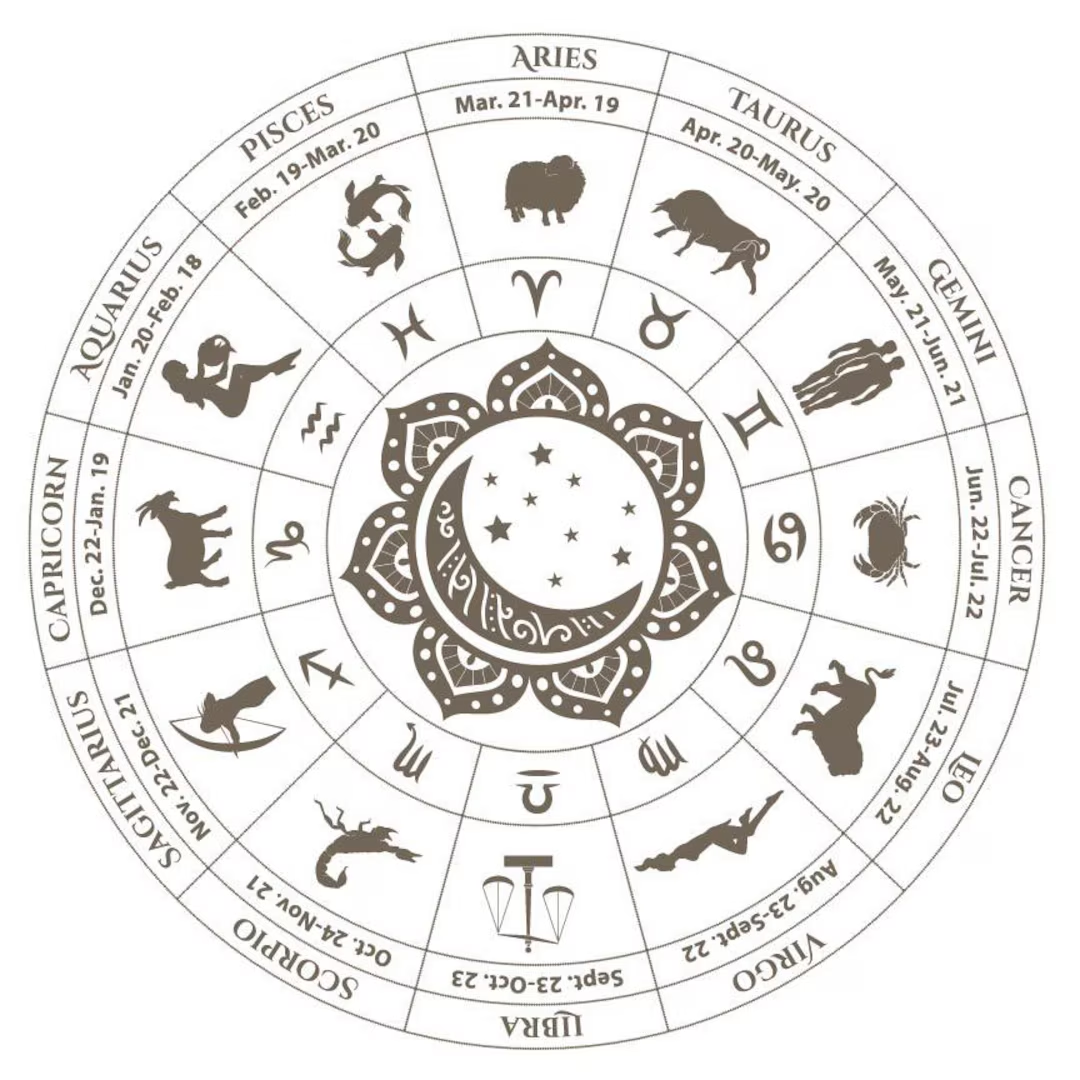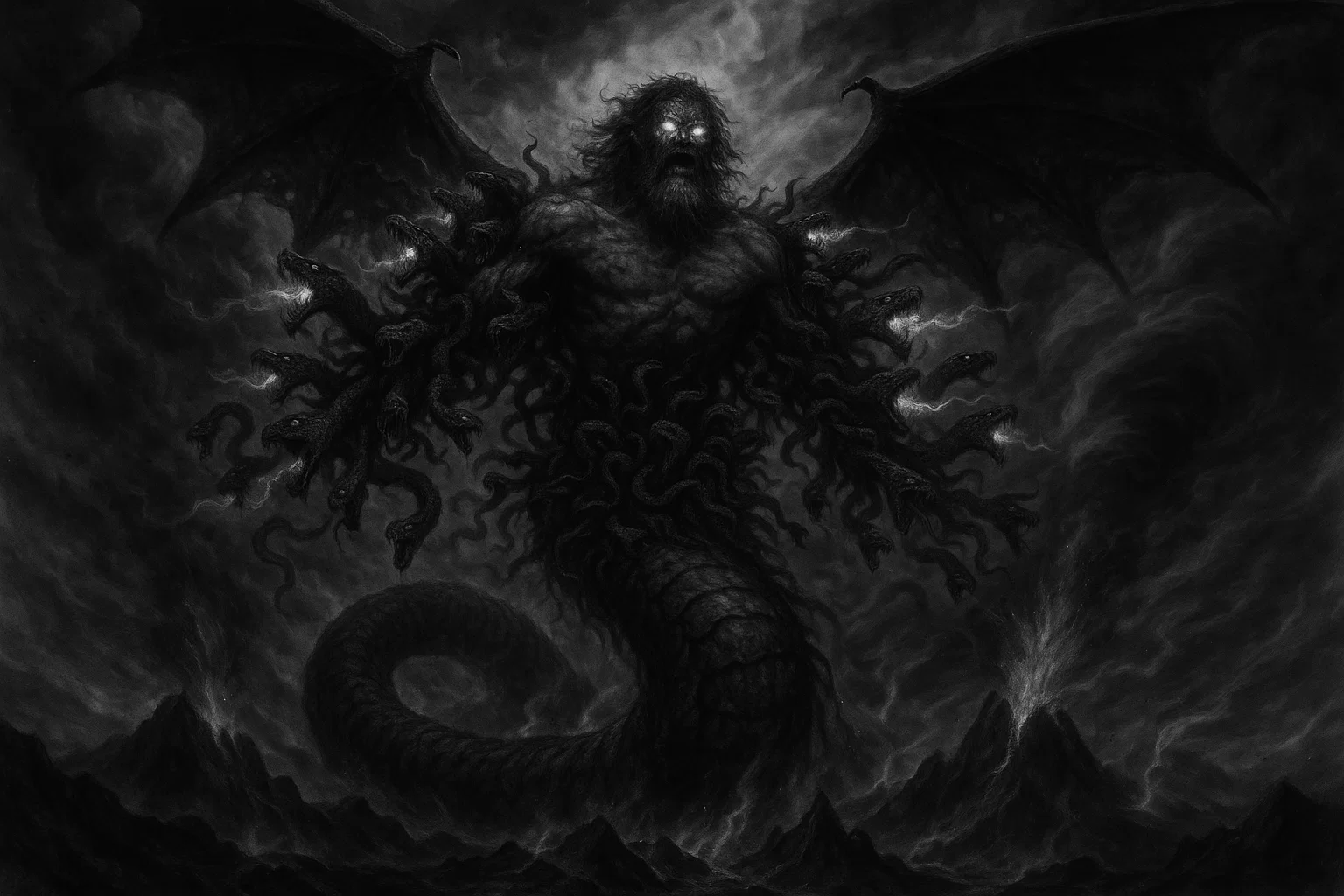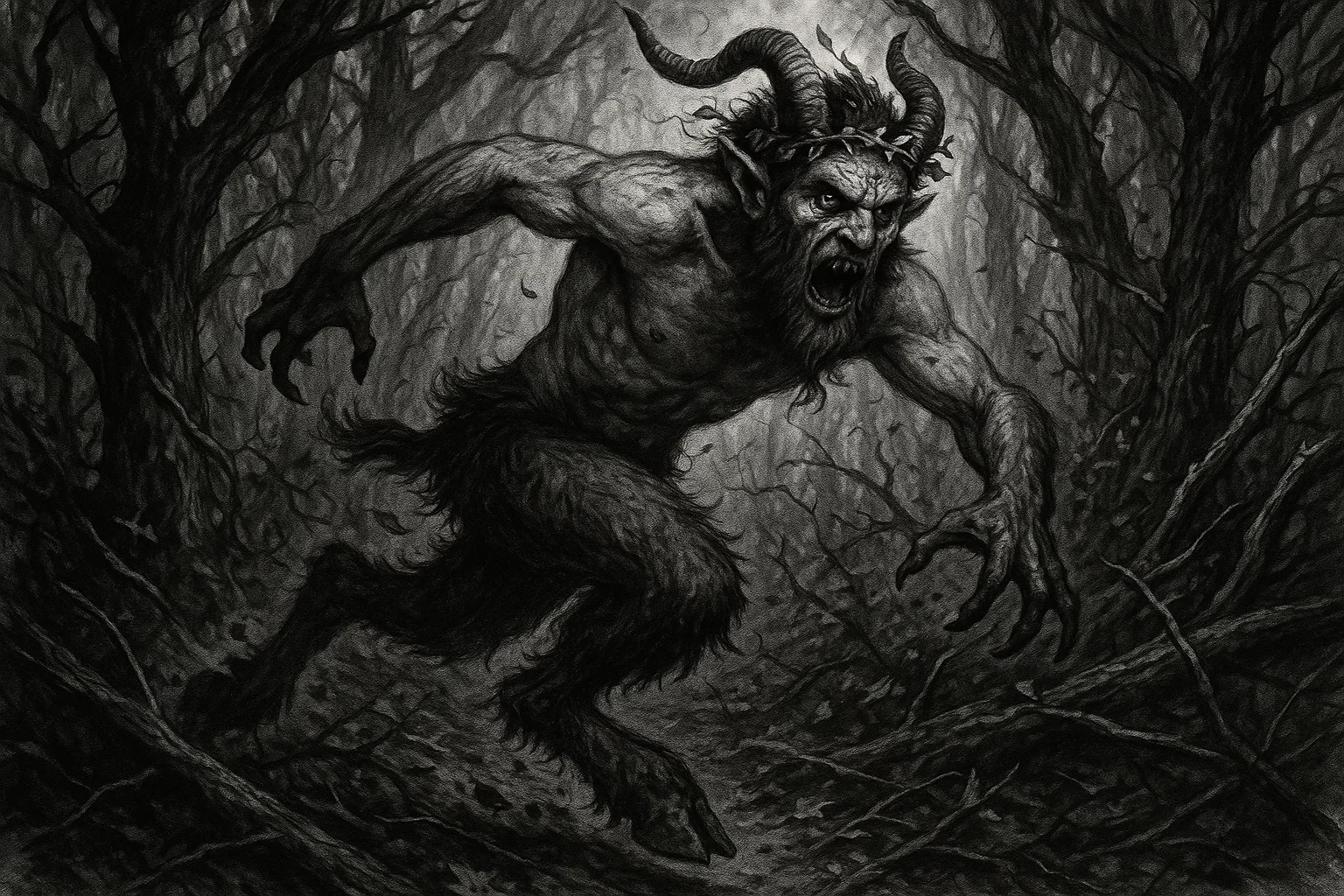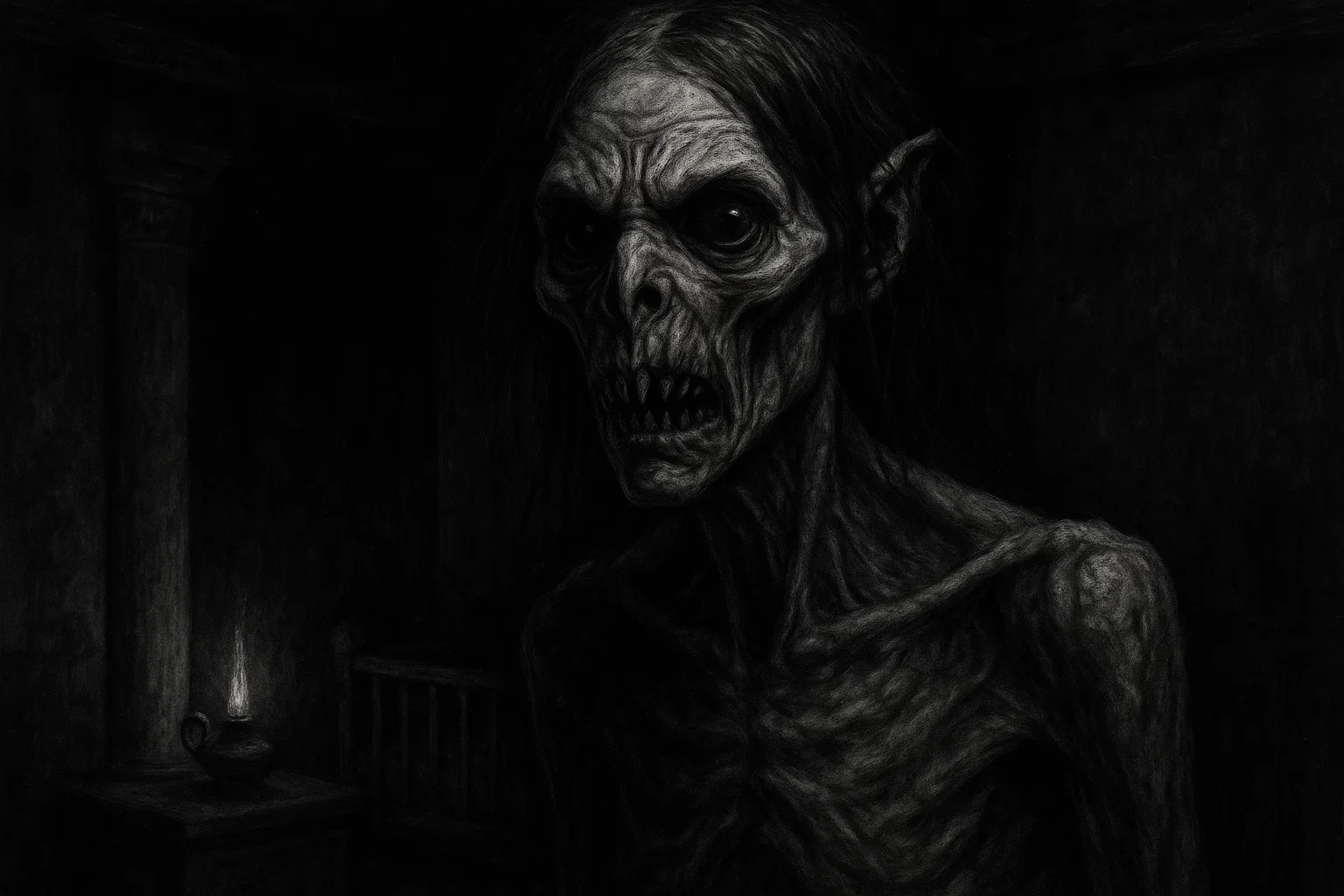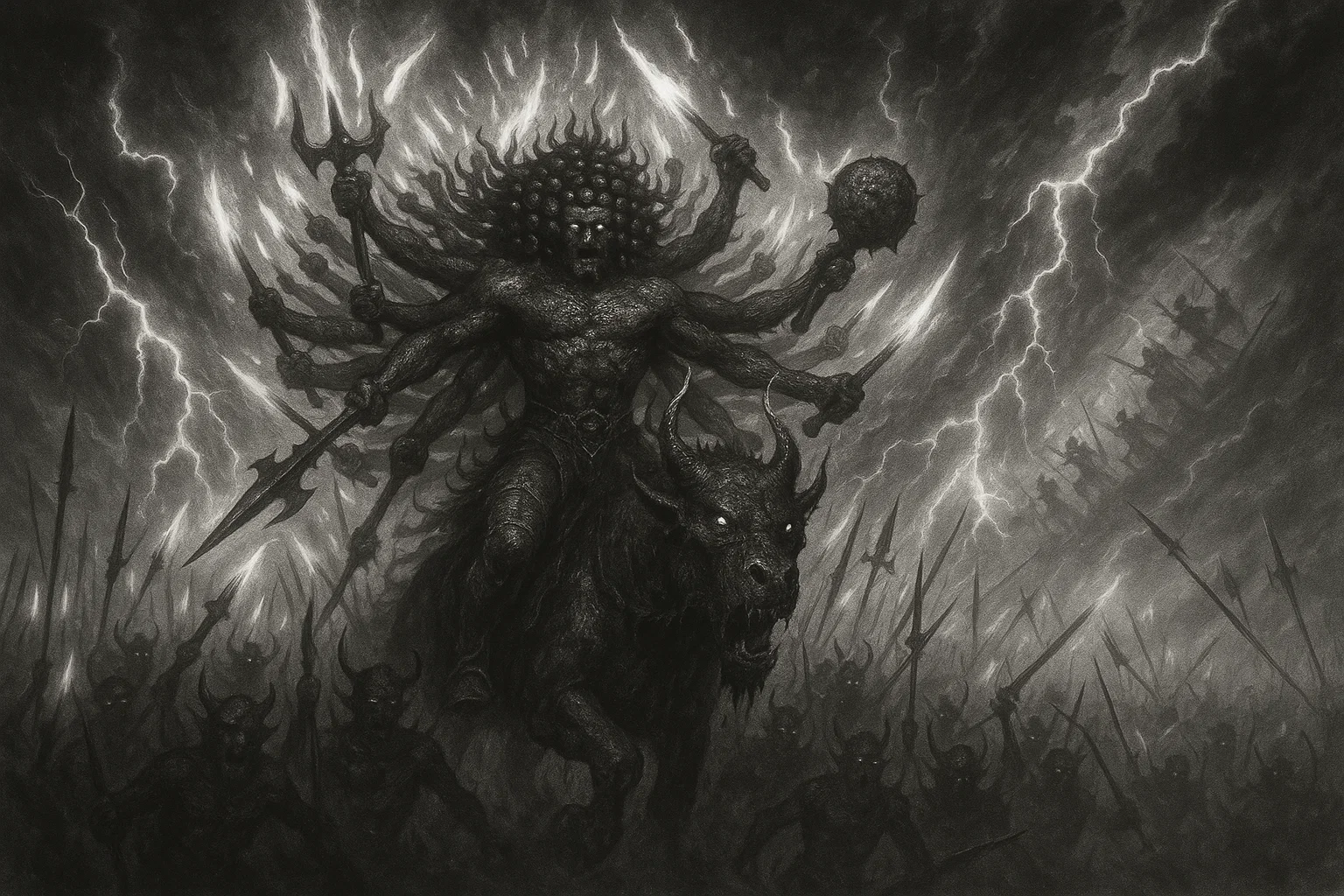The Abada is a mythical creature from Central African folklore, often referred to by Europeans as the “African Unicorn.”
Unlike its famous Western counterpart, the Abada is described not as a graceful white horse with a single spiraled horn, but rather as a sturdy, donkey-sized beast possessing two crooked horns.
Summary
Overview
| Attribute | Details |
| Name | Abada |
| Aliases | Nillekma, Arase |
| Threat Level | Benign; Believed to be a protector and healer. |
| Habitat | Dense tropical rainforests and wilderness of Central Africa, primarily the Kongo region (Democratic Republic of the Congo) and historically Kurdufan (Sudan). |
| Physical Traits | Roughly the size of a small donkey; sturdy, compact body covered in dark or bristled hair; possesses a tail like a wild boar; defining feature is its two crooked, asymmetrical horns. |
| Reported Sightings | Mainly referenced in Central African oral traditions and folklore; no authenticated modern cryptozoological sightings exist. |
| First Documented Sighting | Existence documented through the transcription of Central African folklore by European explorers and ethnographers, primarily from the 19th century onward. |
| Species Classification | Mythological creature; Speculative unknown ungulate (mammal). |
| Type | Terrestrial; Forest-dwelling (arboreal/sylvatic). |
| Behavior & Traits | Elusive, spiritual, and benevolent; said to appear to those who are lost or ill; its horns are believed to be a potent antidote for poison and disease. |
| Evidence | Anecdotal eyewitness accounts derived from folklore; no physical evidence such as photographs, footprint casts, or biological remains. |
| Possible Explanations | A purely mythological entity tied to cultural beliefs; misidentification of real African mammals, most notably the Rhinoceros or the Okapi (which was itself an undiscovered cryptid). |
| Status | Ongoing mystery, but primarily studied as a figure of mythology and cultural heritage. |
Who or What Is Abada?
The Abada is a strange cryptid in the folklore of the Kongo people of Central Africa. Although it is commonly linked to the European unicorn because it is a magical, horned ungulate, the Abada possesses a unique identity far removed from the medieval image of purity.
It is seen not as a fragile white creature, but as a robust and resilient force of nature. Within the Kongo cultural framework, the Abada symbolizes protection, spiritual wisdom, and cultural heritage. Its stories are passed down through oral tradition, serving as moral lessons about hope and intervention.
Crucially, Abada’s two horns, rather than a single spire, set it apart. These horns are the source of its legendary power, believed to contain potent antidotal qualities capable of curing disease and neutralizing poison.
The creature is generally considered benevolent; it appears to people who are suffering or spiritually lost, offering a mystical blessing and acting as a directional guide in the deep, confusing wilderness of the African forests. It represents the raw, untamed magic residing in the heart of the continent.
Your Personalized, Hyper Accurate Moon & Astrology Reading
Limited time offer: Get your FREE, fully personalized Moon & Astrology Reading that takes astrology to a whole new level. Discover the secret depths of your personality, relationships, and true purpose in life.
What Does Abada Look Like?
Descriptions of the Abada consistently depict a small, sturdy ungulate. It is commonly reported to be about the size of a small donkey, with a compact, durable build that is well-suited for traversing dense forests.
The creature’s body is typically dark-colored, sometimes described as having a rough or bristly hide, which gives it a rugged, protective appearance. One of its most distinctive features is its tail, which is said to resemble that of a wild boar.
The most unique physical characteristic, however, is its headgear. Instead of the single, straight horn of the European unicorn, the Abada has two crooked or asymmetrical horns. These horns are not sleek or ornamental; they are often depicted twisting irregularly, suggesting raw, natural power.
While some speculative accounts have compared Abada’s appearance to a rhinoceros due to its size and the general term “abada” once used for the rhinoceros in parts of Europe, the cryptid is definitively known for having two horns used for medicinal purposes in Central African lore.
You May Also Like: Is Mothman Real? The Eerie Sightings That Say Yes
Habitat
The Abada is said to inhabit the deep, dense tropical rainforests and remote wilderness areas of Central Africa, particularly associated with the Kongo basin and the historic region of Kurdufan (in what is now Sudan).
This environment is characterized by high humidity, thick vegetation, and limited human settlement, providing an ideal, mysterious domain for a creature of myth. The terrain is often challenging, composed of swamps, thickets, and towering trees, which contribute to Abada’s reputation as both hard to find and built for resilience.
Its alleged habitat is symbolically significant. The Abada often appears at the edge of mysterious crossroads or deep within the forest, places that signify transition, danger, and uncertainty. This reinforces its role as a spiritual compass and a guide for the lost.
Unlike creatures that prefer specific bodies of water (like lake monsters) or mountainous areas, the Abada is intrinsically linked to the forest itself, grazing on grass and existing as a key component of the indigenous ecosystem in local belief.
Abada Sightings
Due to its origins, the Abada lacks the specific, dated cryptozoological sightings—such as grainy photographs or detailed logbook entries—that characterize cryptids like Bigfoot or the Loch Ness Monster.
Instead, the history of the Abada is defined by the deep-seated cultural knowledge of the Kongo and other Central African peoples, and the subsequent efforts by Europeans to document or discover the “African Unicorn” they believed the legend referenced.
| Date | Place | Witness Details | Description | Reliability |
| Ancient/Unknown | Kongo Basin, Central Africa | Kongo and Pygmy Cultural Leaders | Persistent folklore describes a small, two-horned, benign ungulate whose horns neutralize poisons and cure sickness. | High: Deeply integrated, consistent folklore across generations and tribes. |
| Mid-19th Century | Western and Central African Interior | European Explorers and Hunters | Anecdotal accounts recorded in journals regarding persistent rumors among local guides of a secretive, two-horned, unicorn-like animal inhabiting the deep forests, which the Europeans began searching for. | Medium: Anecdotal, secondary accounts reported in colonial-era texts, but consistent regarding the animal’s traits. |
| 1901 | Ituri Forest, Democratic Republic of the Congo | Sir Harry Johnston | The search for the “African Unicorn” culminates with the discovery of the Okapi, an animal previously unknown to science, which was often conflated with various local unicorn myths, including the concept of a secretive forest ungulate. | Low: Not a sighting of the Abada, but the primary rational outcome of the “African Unicorn” investigation. |
Awaken XT is unlike anything you’ve ever tried before…
…it’s based off a closely guarded formula that’s said to be able to supercharge your pineal gland and help you access your untapped inner power. With it’s unique blend of extremely hard to source ingredients, Awaken XT helps support the healthy functioning of your pineal gland, as well as your other organs in your body.
The Oral Tradition of the Kongo People
The most reliable evidence of the Abada comes from its persistent presence in the oral traditions of the Kongo people. For generations, the creature has been described consistently as a dark, two-horned guardian whose powers are intrinsically tied to healing.
The “sighting” in this context is the cultural memory of the creature itself, which is far more consistent and long-lasting than transient individual sightings.
Tales describe shamans or spiritual healers seeking out the Abada—or its shed horns—to harness its potent antidotal properties, emphasizing its role not as a monster, but as a sacred and magical figure. This tradition holds the Abada as a verifiable truth within the local spiritual system.
You May Also Like: Cadborosaurus: Is the Pacific Northwest Hiding a Sea Serpent?
The 19th-Century Search for the “African Unicorn”
During the 19th and early 20th centuries, European explorers and colonial administrators, aware of the ancient European unicorn legends, became fascinated by persistent African accounts of a single- or two-horned forest animal.
These rumors led to a concerted effort to find the “African Unicorn.” The descriptions they collected often matched the Abada’s generalized traits: a mysterious, shy, horse-like or donkey-like creature inhabiting the dense, unexplored forest.
These foreign expeditions and recorded interviews with local guides constitute the earliest documented context of the creature, even though the Abada name was often overshadowed by the generic search.
The Okapi Discovery (1901)
While not a sighting of the Abada itself, the discovery of the Okapi (Okapia johnstoni) in the Ituri Forest of the Democratic Republic of the Congo in 1901 is the most significant event associated with the “African Unicorn” search.
Sir Harry Johnston, relying on local reports, eventually acquired skin and skeletal evidence of the Okapi, an animal previously unknown to Western science. The Okapi, a forest giraffe, has a unique, secretive appearance.
Many cryptozoologists and scientists later proposed that the generalized tales of the Abada, and other African “unicorns,” were either misidentifications of the Okapi or that the discovery of the Okapi fulfilled the exploratory desire to find the mythical creature.
Evidence & Investigations
Evidence concerning Abada’s physical existence is entirely anecdotal and mythological. There is no surviving scientifically verifiable physical evidence—no plaster casts of footprints, no purported photographs, no audio recordings of vocalizations, and certainly no skeletal or tissue samples—that confirms the creature’s presence in the modern era.
Investigations into the Abada and similar “African Unicorn” cryptids have transitioned from pure folklore collection to a search for zoological specimens, leading to surprising discoveries.
The most intense period of investigation occurred during the late 19th and early 20th centuries. Explorers were driven by the medieval European tradition that upheld the unicorn’s medicinal properties, especially its horn (alicorn), and sought out a biological source for the African stories. While the search did not confirm the Abada legend, it did lead to a major zoological breakthrough: the discovery of the Okapi in 1901.
This discovery, made from a region where similar unicorn myths persisted, is viewed as a negative correlation for the Abada’s existence.
Cryptozoologists have proposed that the Abada could represent a surviving species of an unknown, small bovid or cervid adapted to the dense forest environment, yet to be formally described.
However, no credible expedition has ever returned with compelling evidence. The lack of physical evidence, combined with the creature’s powerful cultural role as a spiritual totem, strongly suggests that the Abada functions primarily as a mythological being in Central African culture rather than as an extant biological species awaiting discovery.
You May Also Like: The Nandi Bear: Africa’s Terrifying “Brain-Eating” Cryptid
Theories
Several theories attempt to explain the origins and persistence of the Abada legend, ranging from zoological misidentification to its role as a spiritual archetype. These theories attempt to place the creature within either a scientific or cultural context.
Misidentification of the Okapi
The most commonly proposed scientific explanation is that the Abada legend, along with other “African Unicorn” tales, is based on misidentified or exaggerated accounts of the Okapi (Okapi johnstoni). Before its formal discovery in 1901, the Okapi was entirely unknown to the Western world, residing deep within the Ituri Forest.
It is a solitary, shy ungulate that is extremely difficult to spot. Its unique appearance—a blend of zebra-like stripes on its legs and a reddish-brown body—could easily be distorted through repeated oral retellings, especially regarding its horn structure.
Although the male Okapi has two short, skin-covered horns (ossicones), the description of Abada’s two crooked horns may be a cultural interpretation of this unique forest-dwelling mammal.
The Rhinoceros Connection
Another strong theory links the Abada directly to the rhinoceros.
Historically, the word abada is derived from the Malay word badak (rhinoceros), and was used in the 16th century in Europe to refer to the Indian rhinoceros, which possesses one horn. Furthermore, Africa is home to both the one-horned Black Rhinoceros and the two-horned White Rhinoceros.
Given Abada’s description as being sturdy and compact (with some historical accounts even drawing direct comparisons), it is plausible that the folklore is a regionalized, mythological interpretation of the rhinoceros, with its horn(s) being imbued with magical properties for healing and protection—a belief common to rhinoceros horn in many cultures.
You May Also Like: Popobawa Sightings: Inside Zanzibar’s Most Feared Cryptid
Cultural Archetype and Spiritual Totem
The theory that the Abada is a purely mythological figure and spiritual archetype is widely accepted among ethnographers. In this view, the creature’s reality is found in its function within the Kongo spiritual and moral system, rather than in biology.
The Abada serves as a benevolent figure, a guardian of the lost, and a source of healing magic. Its two horns symbolize its power to counter poisons and disease. The continuous storytelling reinforces community values, offering hope in the face of illness or disaster.
Therefore, the creature is “real” as a cultural and psychological entity, irrespective of its physical existence.
Comparison with Other Similar Cryptids
The Abada can be compared to other cryptids, particularly those that are large African mammals or that represent mythological attempts to explain the unknown world. The table below compares Abada’s characteristics to those of other comparable bizzare creatures.
| Cryptid | Location | Key Physical Trait | Classification/Type | Primary Possible Explanation |
| Mokele-mbembe | Republic of the Congo | Large, semi-aquatic, long neck, small head | Reptilian/Dinosaur-like (Sauropod) | Misidentified elephants, rhinoceroses, or large reptiles. |
| Nandi Bear | East Africa (Kenya) | Large, shaggy, nocturnal carnivore with sloping back | Mammal (Unknown large carnivore) | Misidentified Hyena, Honey Badger, or an unknown extinct bear species. |
| Emela-Ntouka | Republic of the Congo | Ox-sized, powerful, singular horn, slayer of elephants | Reptilian/Dinosaur-like (Ceratopsian) | Misidentified Rhinoceros or strong local mythology. |
| European Unicorn | Medieval European Forests | White horse with a single, spiraled horn | Mythological Mammal | Exaggerated accounts of Narwhal tusks and Rhinoceros horn. |
| Okapi | Ituri Forest, D.R. Congo | Forest giraffe; zebra-striped legs, male has two short ossicones | Real Species (Former Cryptid) | Its initial discovery fulfilled the search for the “African Unicorn.” |
| Yeti | Himalayan Mountains, Asia | Large, bipedal, ape-like creature covered in white/gray hair | Hominid/Primate | Misidentified Himalayan Brown Bears or local folklore. |
| Mapinguari | Amazon Rainforest, South America | Giant, foul-smelling, bipedal, covered in hair | Mammal (Giant Ground Sloth) | A surviving species of Giant Ground Sloth or misidentified giant anteater. |
| Jersey Devil | Pine Barrens, New Jersey, USA | Horse head, bat wings, small arms, forked tail, hooves | Demonic/Hybrid/Unknown | Misidentified birds (Sandhill Crane) or local legend. |
You May Also Like: Is the Shetani a Demon, a Spirit, or Something Else Entirely?
Is Abada Real?
Whether the Abada is “real” depends on the definition applied. From a cryptozoological perspective, definitive proof of its existence remains mysterious.
The creature exists solely in the realm of folklore and oral tradition; there are no verified sightings, footprints, or biological samples to support the existence of a unique, two-horned, donkey-sized ungulate. The evidence strongly suggests that the legend is either a spiritual metaphor or a distorted recollection of an established species, such as the rhinoceros or the Okapi.
However, from a cultural and anthropological standpoint, the Abada is undoubtedly real. It is a powerful symbol of healing, protection, and spiritual guidance for the Kongo people, deeply woven into their identity.
While science posits that the creature is a manifestation of local knowledge about the natural world—and perhaps the historical search for the mythical unicorn—the Abada’s impact on cultural heritage and storytelling is undeniable.

